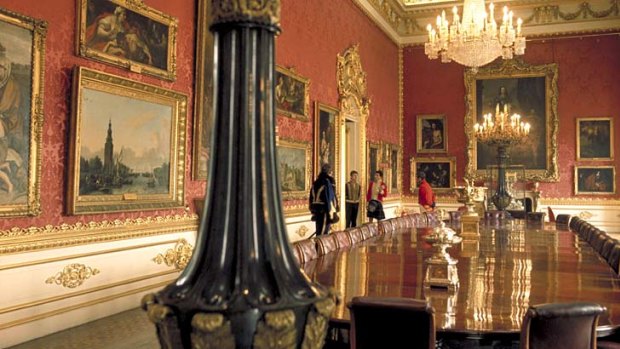This was published 12 years ago
Spoils of victory
What is a giant nude statue of his enemy doing in the Duke of Wellington's palatial home? Caroline Baum finds out.

Hero's home ... one of the ornate rooms at Number One, London.
You can't miss it: there in the foyer of the first Duke of Wellington's home, known as Number One London for its unrivalled address on Hyde Park Corner, is a 3.45-metre marble nude of his arch enemy, Napoleon. Muscled and patrician, it bears no resemblance to the short, stumpy man of reality. The idealised figure, in the Roman style - half god, half emperor, buck naked - is so heavy that the floor had to be reinforced to support it. But why would Britain's hero and Europe's saviour want such a monumental statue of the man he reduced to a pitiful exile and prisoner?
The statue was commissioned by Napoleon from Italian sculptor Antonio Canova. But when he got it, he didn't like it. Even with his over-endowed ego, he recognised the work was an absurd exaggeration of his physique, its towering height perhaps only serving to emphasise his lack of it. "Too athletic," he complained. He gave it to the Louvre and the British government bought it for Wellington in recognition of his service to the nation in defeating the French emperor at Waterloo in 1815.
Apsley House is a monument to that victory. One of the best ways to experience its opulent interiors is just on dusk, on the weekly torchlight visits hosted by the curator of the house's remarkable collection, Josephine Oxley. Visitors are welcome to bring a torch but while the dimmed lighting compromises visitors' ability to see the paintings in great detail, the advantage is the more authentic period ambience.
When it comes to silver, the duke's collection is stupendous. Its star turn is the table centrepiece consisting of 21 tableaux made up of 1000 pieces depicting allegorical scenes and mythical creatures. A gift from the Portuguese in gratitude to the duke for liberating them in the Peninsular War from - you guessed it - Napoleon, it took three years to make (mostly by artisans more familiar with making weapons than table decorations) and required such a vast quantity of silver that coinage was melted for it and resulted in a crippling expense for the war-ravaged nation. A fascinating painting in one of the galleries shows the table in use at the inaugural Waterloo dinner, which will be re-created in 2015 on the occasion of the bicentenary of the battle that sealed Napoleon's fate.
In the modestly named plate room is a magnificently elegant dinner service commissioned by Napoleon as a divorce gift to the Empress Josephine, depicting scenes from his Egyptian campaign and including a centrepiece of a Pharaonic temple. Each piece of porcelain is hand-painted and edged in gold against the deep blue background that became a signature of the Sevres factory. But Josephine did not like the service and never used it. Later, King Louis XVIII took great satisfaction in presenting it to Wellington, accompanied by a letter in which he described his lavish gift somewhat disingenuously as "a few plates", adding "little gifts keep friendship alive".
An ardent Francophile, Wellington was clearly a little obsessed with his enemy; there are several portraits of him in the upper galleries, along with those of other members of his family. There are also works by Velazquez (The Waterseller of Seville, looted from the French who in turn had looted the work from the Spanish who, when it was returned to them, gave it to Wellington); Goya (a portrait of the duke for which he sat in Madrid but hated); Brueghel; and Correggio. No private apartments are on view as these are still in use by the family, including the current duke (the eighth to bear the title), who is now 96. One can only wonder how he manages the elegant spiral staircase designed by Robert Adam to curve so lightly up to the third floor.
But the first duke was not just a trophy collector, he was also interested in the latest ideas in design. One ingenious example is the way the large gilded mirrors that line one wall of the long gallery - used at night to double the impact of the lit candelabra - slide away to reveal floor-to-ceiling windows by day. Those who witnessed the effect and how it transformed the room would no doubt have been impressed. But then, when your house is home to the greatest aristocratic hero of the age, understatement is hardly the name of the game.
Apsley House torchlight visits take place on Thurdays at 6pm. The cost is £15 ($22).The house is at 149 Piccadilly, Hyde Park Corner. Normal entry costs £6.30 for adults, book ahead. See www.english-heritage.org.uk/daysout /properties/apsley-house.
Sign up for the Traveller Deals newsletter
Get exclusive travel deals delivered straight to your inbox. Sign up now.